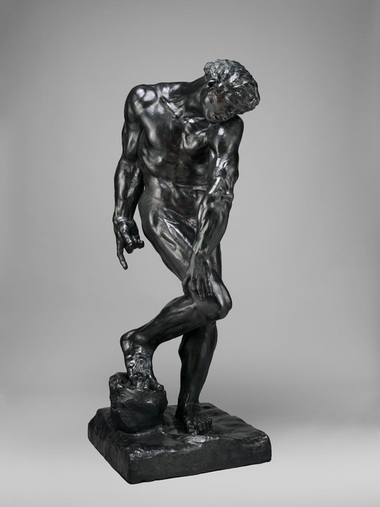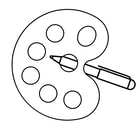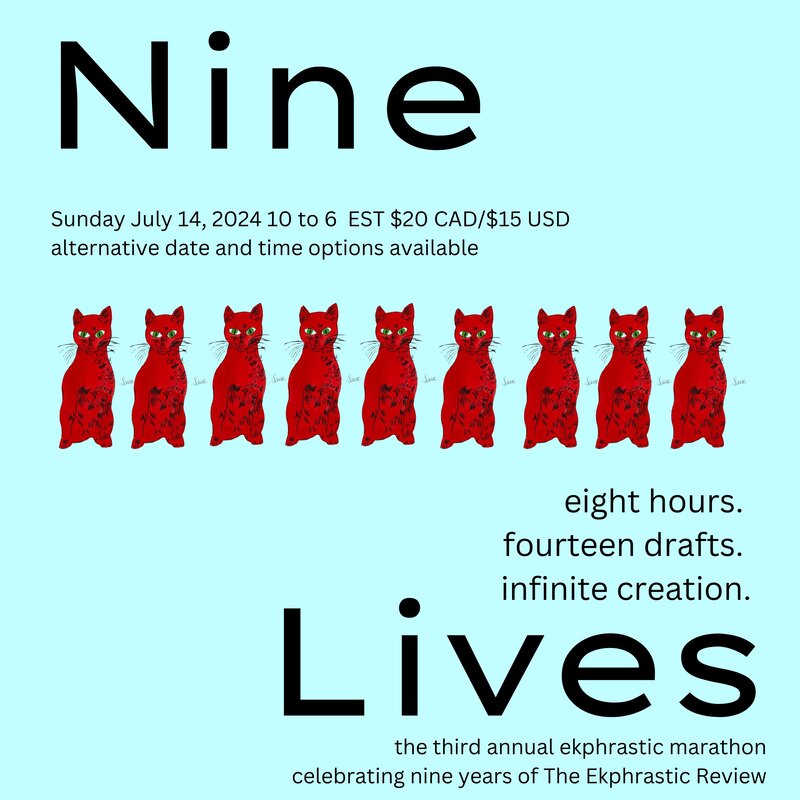|
Adam at the Art Institute
Rodin’s Adam stands at the top of the stairs, more than life-size, looking as if he’s about to throw something. His left arm rests on his bent right leg; his right arm reaches back, as if gaining momentum for the release of some (invisible) object. The pose reminds me of the fifth-century Roman sculpture the Discus Thrower. To duplicate the discus thrower’s stance, all he needs to do is raise that right arm farther up behind him, bend his shoulders a bit more forward, and grip his fingers around a round metal plate. And wipe that sad expression off his face. Adam is my neighbour at the Art Institute, where, as a volunteer, I sit at an information kiosk explaining to visitors how to find the American wing, or the Picassos, or the toilet. Visitors flow steadily up and down the Grand Staircase, many of them pausing to ponder Rodin’s depiction of their earliest ancestor. Often they say something to me as they do so: “Look how big his head is,” or “Where’s Eve?” or “That position looks awkward.” They bend to read the label, which explains that Rodin based the figure on Michelangelo’s portrait of Adam in the Sistine Chapel. There, a newly created Adam reclines, his index finger receiving the breath of life from God’s extended fingertip. But Rodin has tipped him upright, as if to say, “Time to be up and about. Let’s look at what we’ve got here.” What we’ve got, though, doesn’t look too good. Adam has caved in on himself, eyes cast down, as if he’s contemplating his own flawed flesh. His right arm reaches not out toward God but downward, and his index finger—in Michelangelo’s depiction nearly touching God’s—now points uselessly toward the earth. Although he seems poised for action, his feet are glued to the statue’s base. If he were to move, it’s easier to imagine him toppling over than actually completing whatever motion he’s embarked on. But then, Adam is all about toppling. Rodin originally sculpted the figure to be paired with Eve at a portal entitled The Gates of Hell, the Art Institute website explains. Rodin’s inspiration was Dante’s Adam, who, before being raised to the left side of God, spent thousands of years in Limbo. His “agonized body,” we’re told, “strikingly conveys the sufferings caused by original sin.” Rodin’s version may aspire to the fluid power of the Discus Thrower, but his muscles are knotted, his hands and feet too huge and ill-proportioned for grace. Those feet anchor him to the earth to which his sin has bound him (Adama: earth, in Hebrew), and on which he’ll now have to labour. Adam’s awkwardness (old Norse: turned the wrong way) is, I think, why so many visitors stop not only to contemplate but also to interact with him. Adam’s twisted pose pulls visitors in, as if they feel his knotted muscles in their own bodies. I’ve seen multiple young men imitate his pose, swaying unsteadily as their friends take pictures. I’ve seen one man link an index finger through Adam’s, as if in solidarity, and another rest a hand on Adam’s calf as he posed for photographs. When I saw the man touch Adam’s leg, I thought of intervening: everyone knows, after all, you’re not supposed to touch the art. But I figured by the time I rebuked him, he’d have removed his hand. In any case, I was touched. I thought of Lincoln’s head at Springfield, his nose shiny from the touch of passersby, and thought perhaps Adam, more than any other work of art, should bear the mark of his fellow creatures’ caress. Museums offer a charged space in which sparks of affinity leap between viewer and object. Watching these intense responses to art, I feel like a lucky witness to the best that human beings can be: curious, receptive, eager, kind. They connect with each other—and me—as well as with what they see: a husband, pushing his wife in a wheelchair, reads her the labels she can’t see; a woman excitedly points out to her friend the Frank Lloyd Wright window suspended from the ceiling above me; a young man high-fives me when I give him a flyer about our mini-tour based on Ferris Bueller’s Day Off. I even become a strange kind of confidante, to whom they trust their uncertainties. Not just “Where is the nearest rest room?” But, “These are all replicas, aren’t they?” “You mean this is the only real American Gothic?” “Haven’t I seen a painting of Van Gogh’s bedroom somewhere else?” I thrum with sympathy, listening to these questions. What does “original” mean, after all, given that artists often paint or sculpt the same thing more than once, and that sculptures are cast multiple times, sometimes after the artist’s death? In how many different places have I seen Rodin’s Balzac? There’s our own, a naked figure in Gallery 201, whose crotch melts between his legs into what looks like a traffic cone; there’s his sibling, perched identically in the sculpture garden of the Baltimore Museum of Art; and there’s the massive, enrobed figure striding through the garden of the Rodin museum in Paris. Each question strikes me as complex and worth thinking about. “What makes a painting get so famous?” a young man asks me, after I explain where he can find Grant Wood’s American Gothic. Even “where is the nearest toilet?” requires a thoughtful, contextualized response. “What did you want to see on the way there?” I ask. But man, alas, is a fallen animal. That couple I thought was passionately discussing Rodin’s Adam is in fact quarreling about when to get lunch. “We’ve already waited six hours,” one insists, as loudly as you can in a museum without drawing the attention of a guard. “Let’s go.” And then there was the wealthy looking middle-aged couple who paused to ask me directions. “How do I get to the modern wing?” the woman asked. I told her. “How do I get to the armour?” the man asked. The woman re-inserted herself in the conversation before I could answer. “We’re not going to see the armour,” she said disgustedly. “We’re going straight to the modern wing.” The husband, ignoring her, asked me again, “How do I get to the armour?” “Go straight, behind the Caillebotte,” I said, in my standard explanation, “until you see furniture on the right. Then turn right and keep going.” The woman turned to go, but then paused and looked at me angrily. “You’re fired,” she said. I smiled politely and glanced at my neighbour Adam to see how he was taking it. He was, as usual, looking at his feet. His sad expression said all that needed saying. Ruth Hoberman Ruth Hoberman retired recently after thirty years as a Professor of English at Eastern Illinois University. She taught and published on modern British literature. Her 2011 book Museum Trouble: Edwardian Fiction and the Emergence of Modernism (U of Virginia P) focused on the depiction of art and museums in early twentieth-century literature. Her poems have appeared in [PANK], Natural Bridge, Spoon River Poetry Review, and Iron Horse Literary Review.
2 Comments
Carla Schine
4/12/2016 07:04:40 pm
A lovely piece of writing on one of my favorite subjects, sculpture! Looking forward to more.
Reply
Art Paxton
4/15/2016 10:40:22 pm
Fun, thoughtful, indeed wise. I enjoyed your light touch with the weighty subject of original sin. You express so well the drooping figure's potential as a discus thrower, I suspect you can throw with "fluid power".
Reply
Your comment will be posted after it is approved.
Leave a Reply. |
The Ekphrastic Review
COOKIES/PRIVACY
This site uses cookies to deliver your best navigation experience this time and next. Continuing here means you consent to cookies. Thank you. Join us on Facebook:
Tickled Pink Contest
April 2024
|




